© 2018 Zhangjiagang YUSHENG MachineryAll rights reserved. Site Map Designed by iwonder.cn
What is PVC Resin?
Polyvinyl chloride is the most commonly used thermoplastic polymer such as PET (Polyethylene Terephthalate) and PP (Polypropylene) made from the polymerization of vinyl chloride. It is an odorless solid plastic which is naturally white and brittle in nature.
It is a synthetic resin made of 57% Chlorine (derived from industrial salt) and remaining 43% comprising of Carbon (derived from oil and gases). It is comparatively less dependent on nonrenewable resources (crude oil and natural gas) than other polymers, therefore, can be regarded as resource saving plastic for future.
These polymers offer a wide range of applications due to its versatile nature. It is most commonly used in the construction industry but is also used in a variety of other industries such as transport, packaging, healthcare, electrical/electronic and even it is used as the fiber for clothing.
Grades Available
It is produced in two different forms of grades, first is rigid or unplasticized PVC resin (RPVC and UPVC) and second is the flexible plastic.
Flexible Polyvinyl chloride resins are more soft and amendable than the rigid ones due to the addition of plasticizers such as diisononyl phthalate. Rigid Polyvinyl chloride resins are primarily used for producing pipes whereas flexible ones are commonly used for insulation on electric wires or flooring and in different areas where the sterile environment is a priority.
History
It was first accidentally synthesized in 1872 by German chemist Eugen Baumann and has been produced commercially since the 1920s initially started by B.F Goodrich company.
Properties of PVC Resin
These plastic polymers offer a lot of varied applications in almost all end segment markets where plastics are used. Properties of this material allow flexibility and attract many end-user industries for usage in their products.
These properties include:
They are very dense in composition as compared to their competing plastics.
It is readily available and at very economical prices
It is very hard in nature (especially rigid grade)
Offers more strength & durability
Has a good amount of resistance towards heat, chemicals & stress cracking.
Physical Properties
Properties | Rigid PVC | Flexible PVC |
Density | 1.3-1.45 | 1.1-1.35 |
Thermal conductivity | 0.14-0.28 | 0.14-0.17 |
Resistivity | 1016 | 1012-1015 |
Coefficient of thermal expansion | 5*10-5[20] |
Mechanical Properties
It offers a high amount of hardness & mechanical properties. The mechanical properties increase with increasing amount of molecular weight and decrease with rising in temperature. The mechanical properties include:
Tensile strength – 52MPa
Elongation at break – 50-80%
Elastic modulus – 1.5-3MPa
Electrical Properties
This resin material posses good insulation properties due to its high polar nature the electric properties are inferior to other forms of nonpolar polymers (polypropylene, polyethylene).
The electrical properties of the material are as follows:
Dielectric strength – 1.4-20 Kv/mm
Dielectric Constant (Permittivity) – 3.9 (3.3)
Dissipation factor (power factor) – 0.01 (0.02)
Volume & Surface resistivity – 2 x 1014 Ω.m & 1013 – 1014 Ω
Thermal & Fire Properties
The raw form of material carries a poor amount of heat stability thus, heat stabilizers are added during the production process to attain desired property.
Softening point – 80-84°C
Thermal Conductivity – 0.16 W/(m.K)
Coefficient of thermal expansion – 7 x 10-5 K
Specific heat – 1,000 J/(kg.K)
Flammability – 0.45
Smoke produce index – 6-8(/10)
Chemical Properties
It is resistant towards acids, salts, bases, fats & alcohols. This is the reason it is commonly used for sewage piping.
It is also resistant towards number of solvents, fuels & also some of the paint thinners
PVC Production
These plastic materials are also produced like other plastic polymers through the process of polymerization. It is commonly produced by polymerization of vinyl chloride monomer in three different methods which include suspension, emulsion, and bulk (mass) polymerization.
More than 80% of production is done by suspension polymerization where vinyl chloride (used as raw material) is pressurized, liquefied fed into the reactor. Later in emulsion process, finer resin grades having small particles are produced. Later it is produced in bulk and transported to produce goods.
Global Production Capacity of Polyvinyl chloride
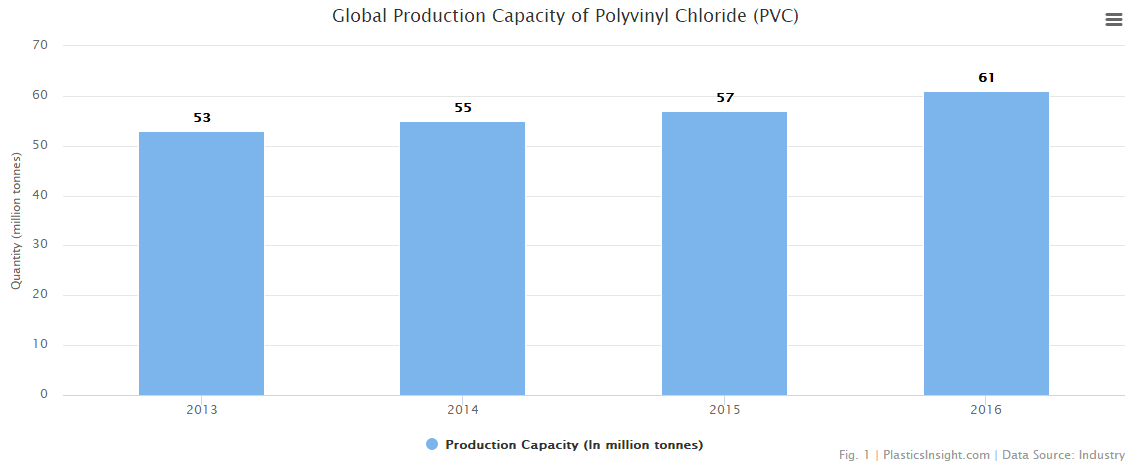
As the graph depicts there has been continuous growth in production capacity of these plastic resins in the forecasted period. The Global Production capacity has reached up to 61 million tons in 2016 from 53 million tons in the year 2013.
There has been a rise in this production level due to increasing demand for this material from end-segment industries. Increasing population, urbanization and rise in income level of people has also resulted in increased demand for this material which accelerates production.
Major sectors responsible for this growth in production due to increased demand for these polymers are building and construction, automotive market & medical sector.
Leading Manufacturers Production Capacity
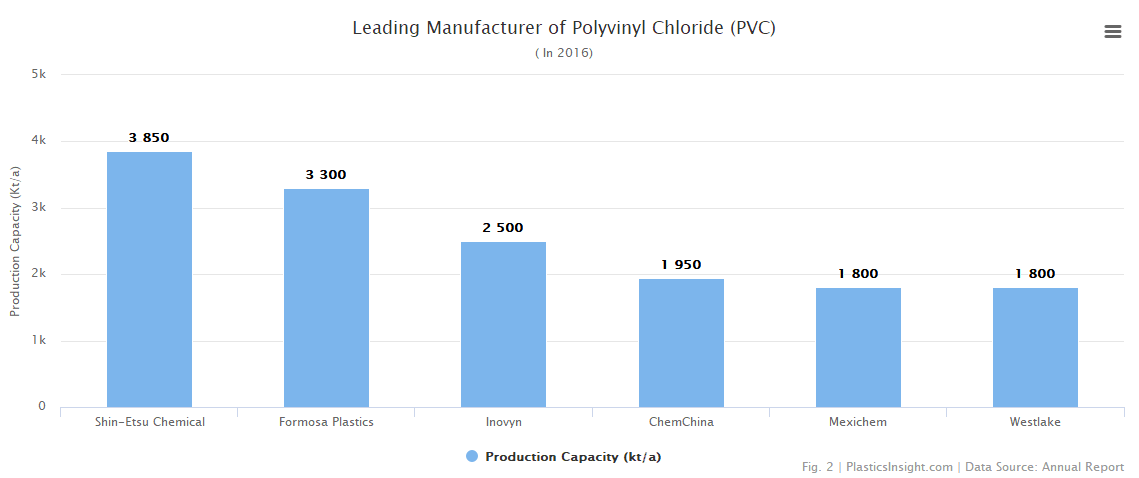
Polyvinyl chloride is a highly competitive market with a number of manufacturers. Leading manufacturers along with their production capacity for the year 2016 are illustrated in the above graph.
Shin-Etsu Chemical has the highest production capacity of 3,850 kt in the year 2016 which is further followed by Formosa Plastics with the production capacity of 3,300 kt.
Other leading manufacturers in the global production market for 2016 include Inovyn with (2,500 kt), ChemChina with (1,950 kt), Mexichem and Westlake with (1,800 kt).
Polyvinyl Chloride Pricing Trend
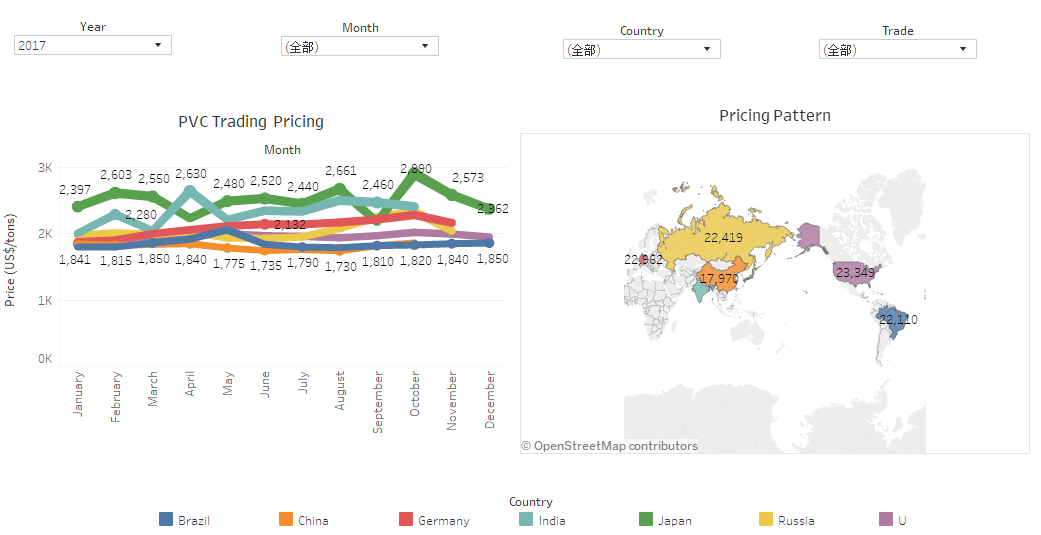
Global Market Demand for Polyvinyl Chloride
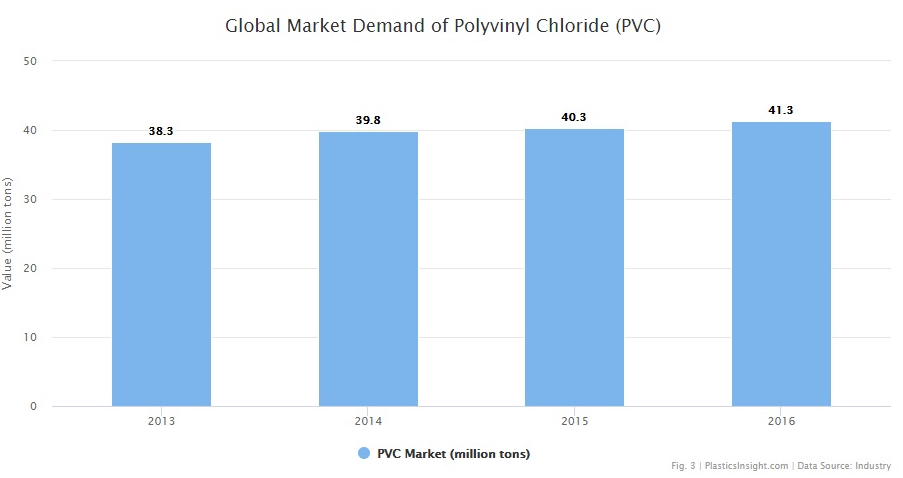
Global Market Demand has witnessed continuous growth in the recent years. The market demand has increased from 38.3 million tons in 2013 to 41.3 million tons in 2016.
Market drivers responsible for this growth in demand include:
Increasing demand from end segment markets (construction, automotive, packaging, footwear & medical etc).
Their unique properties (high performance, lightweight & durability) increase their demand from different sectors.
Continuous research & innovation for usage of this material in different forms or as the replacement also fuel the market demand.
PVC Consumption by Applications
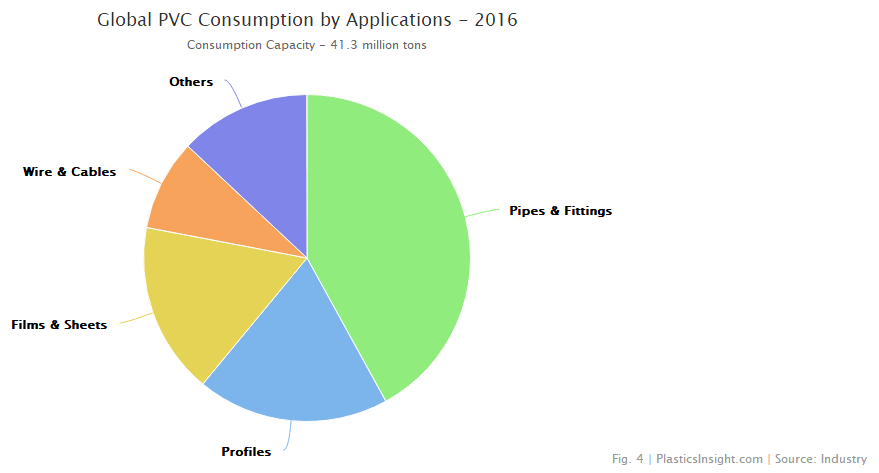
It is a versatile plastic material commonly used for the number of products of end segment market. The above chart depicts the share of prominent applications of the material in consumption for the year 2016.
Construction sector drives the polyvinyl consumption market as pipes & fitting held the maximum share of about 42% in the total consumption (41.3 million tons) for the year 2016. It was further followed by profiles with 19% share.
Films & sheet market also held an important portion of share with 17% contribution in global consumption which was followed by wires & cables that is the electronics sector with 9% share.
Remaining sectors contributed 13% of the total market consumption for the material in 2016.
Per Capita Consumption of PVC (In 2016)
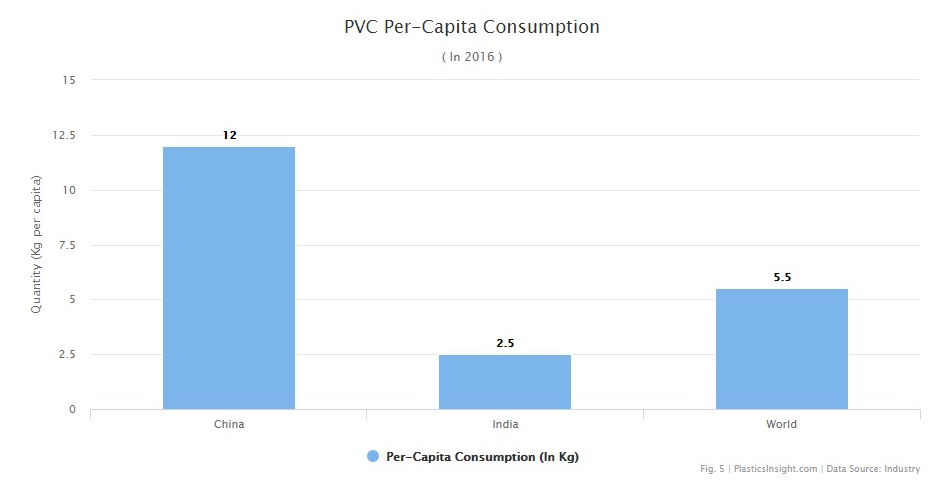
In the year 2016 Global Per capita Consumption for these plastic materials was up to 5.5 kg per capita.
Asian-pacific regions have the maximum contribution in the global consumer market among which China & India have the largest share. Per capita consumption of China in 2016 was 12 kg per capita and India contributed 2.5 kg per capita.
European Countries Sales of Polyvinyl Chloride (2016)
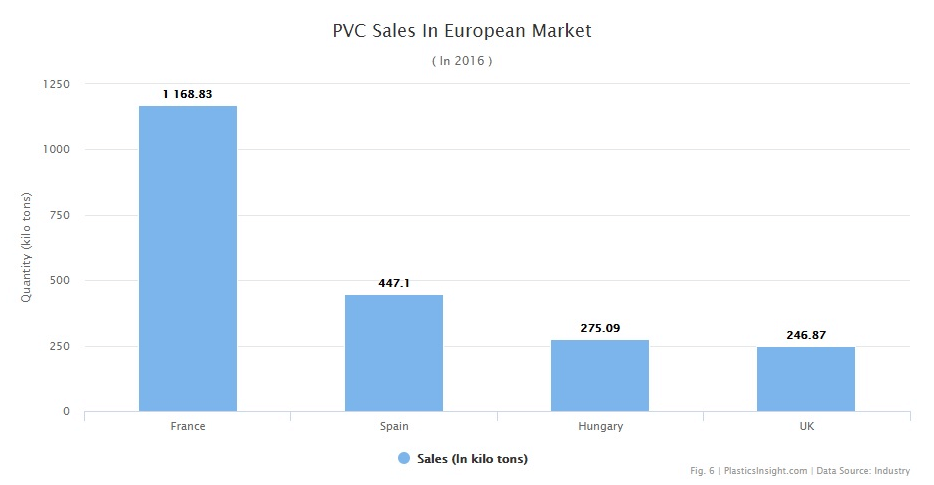
Europe is one of the prominent markets selling these materials globally with an increased amount of sale every year. Among all European regions, France has its maximum contribution with sales of 1168.83 kilo tons previous year followed by Spain with 447.1 kilo tons.
The other two prominent European countries selling this polymer globally are Hungary with sales of 275.09 kilo tons in 2016 followed by the UK with sales of 246.87 kilo tons.
Global PVC Market Forecast
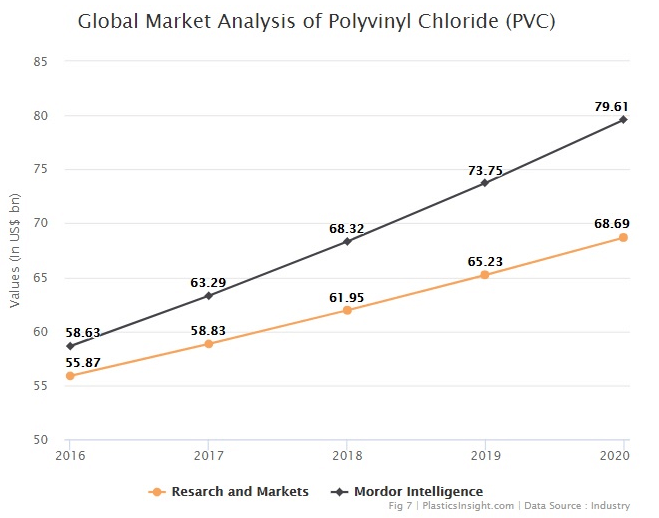
It the third most produced and consumed the type of polymer after polypropylene and polyethylene. Demand for these plastic resins have increased over a period of time and is expected to increase in near future with an increased growth rate.
The global market demand is expected to more than US$ 68bn by 2020.
These materials involve a wide range of applications including electric cables, pipes, furniture, healthcare, fiber, and clothing. They are also being used in a number of daily use products like bottles, credit cards, films & packaging etc.
Market Drivers
The global market demand is primarily driven by construction industry with a number of uses in household, commercial and industrial sector.
Other factors driving the market demand are high-performance plastics are helping to improve fuel economy, increase production and consumption of light weight vehicles, ease of recycling and others.
Market Restraints
The production cost of these resins is highly influenced by its raw material prices such as chlorine, ethylene & acetylene. The fluctuating prices of raw materials especially in Asian-Pacific regions restrain the market growth.
Regional Analysis
Asia-Pacific has the highest demand for these polymers due to rising population, urbanization and increased amount of construction activities in these regions. These regions are further followed by North America, Europe, and South America & Middle East & Africa.
Usually, demand in countries like Europe, Italy, and Germany remains moderate or even stagnant due debt crisis and depressed business environment (slow moderate recovery) in these regions.
Leading Manufacturers
The leading manufacturing companies for these plastic polymers include Aiscondel, Arkema, Chemplast Sanmar Limited, Chemson Group, Formosa Plastics Corporation, INEOS Group Ltd, LG Chem, Ltd, Mitsubishi Chemical Corporation, Solvay, and PolyOne Corporation.
Global Trade of Polyvinyl Chloride
Trade Balance of Polyvinyl Chloride
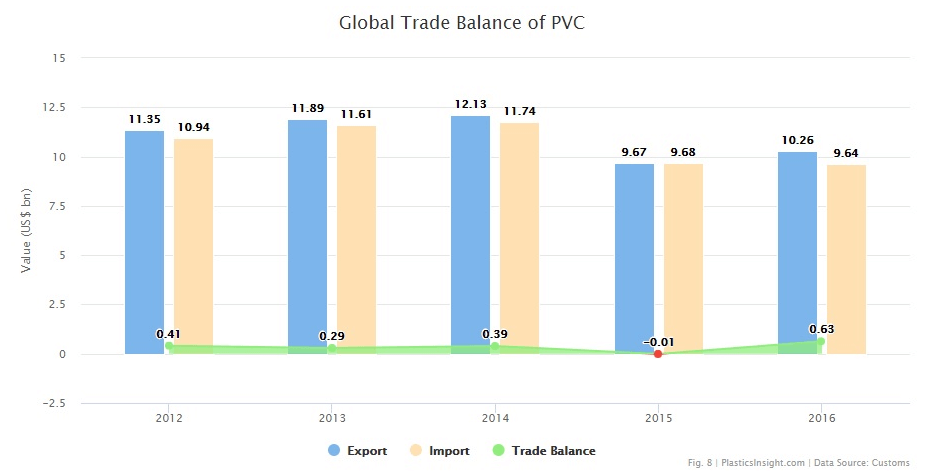
The trade balance of PVC in 2016 was US$ 0.63bn. The export of PVC for the year 2016 was US$ 10.26bn and the import was US$ 9.64bn. The global trade balance of PVC from last five year is constant excepting 2015. The trade balance in 2015 was negative.
Top 10 Exporting Countries of Polyvinyl Chloride

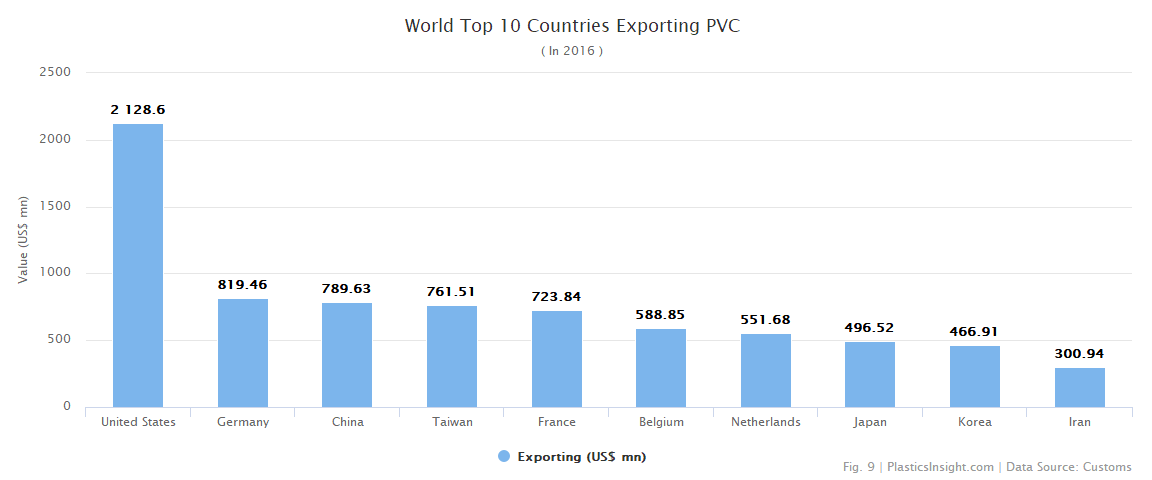
The export market of PVC is dominated by the United States. The United States was the largest exporter of PVC in 2016. It exported PVC polymer in a primary form worth of US$ 2.12bn. The United States has competitive advantages of abundant shale gas which results in low-cost ethylene. Ethylene is the major raw material used in the production of PVC.
The second largest exporter of the polymer was Germany with an export value of US$ 819.46mn. The third largest exporter of PVC material globally was China. It exported the material worth of US$ 789.63mn followed by Taiwan worth of US$ 761.51mn
Top 10 Importing Countries of Polyvinyl Chloride
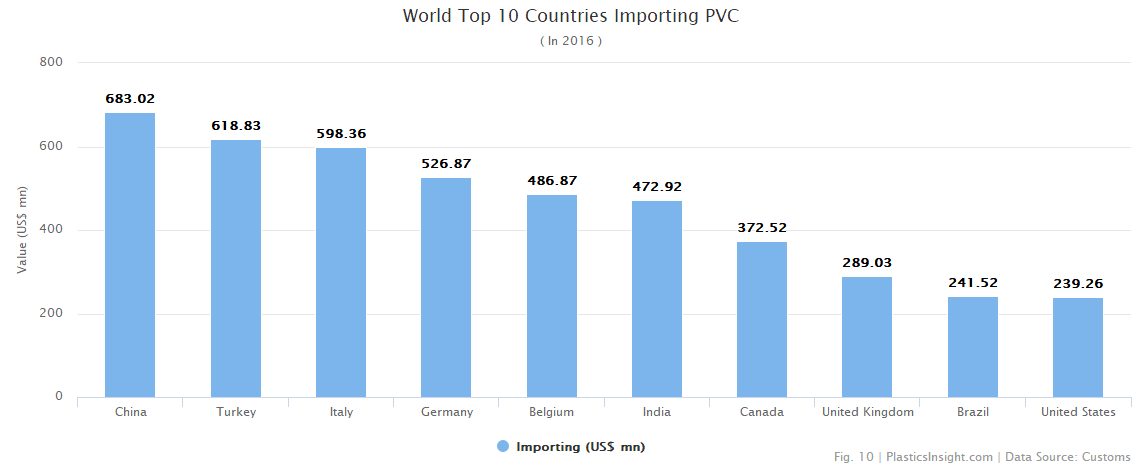
China is the world’s largest importer of PVC polymer in primary form. It imported polymer worth of US$ 683.02mn. The major driver for the Chinese market is because of growth in the construction and infrastructure industries. The demand for PVC pipes & fittings, cables, windows etc is increasing.
The second largest importer is Turkey and it imported polymer worth of US$ 618.83mn followed by Italy US$ 598.36mn.
World Top 10 Importing Countries of PVC Doors, Windows & Frames

Demand for doors, windows, and frames made up of plastics have been continuously increasing due to growing urbanization and commercialization. The adoption rate for plastic doors, windows and their